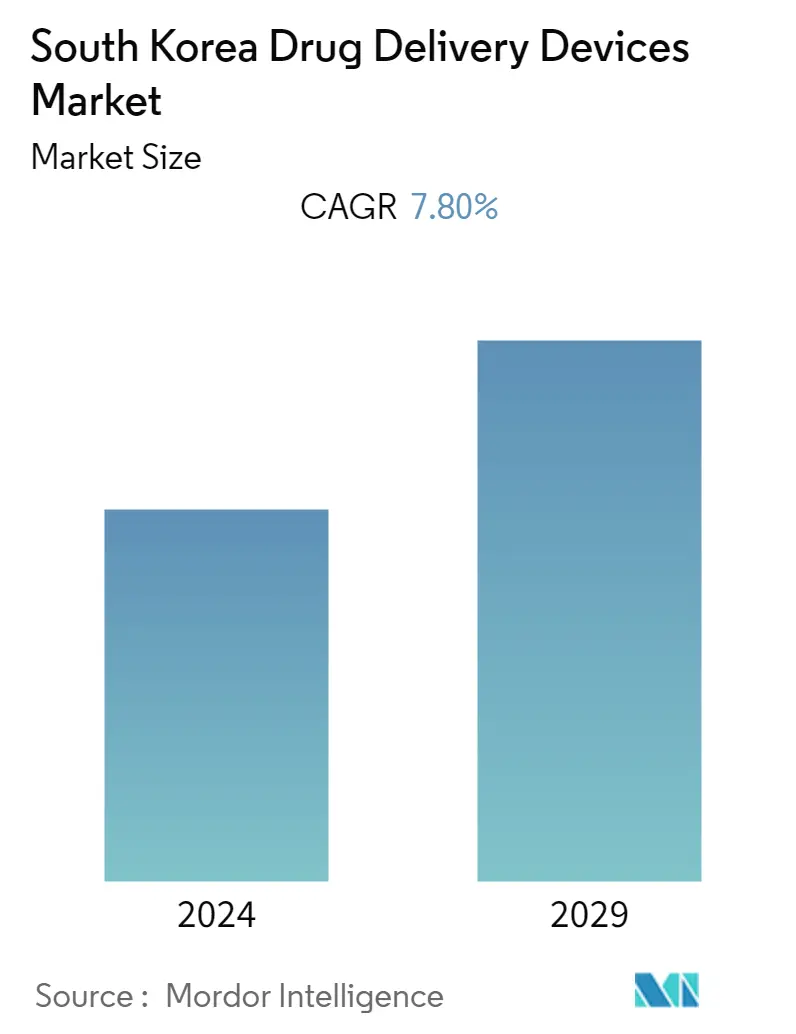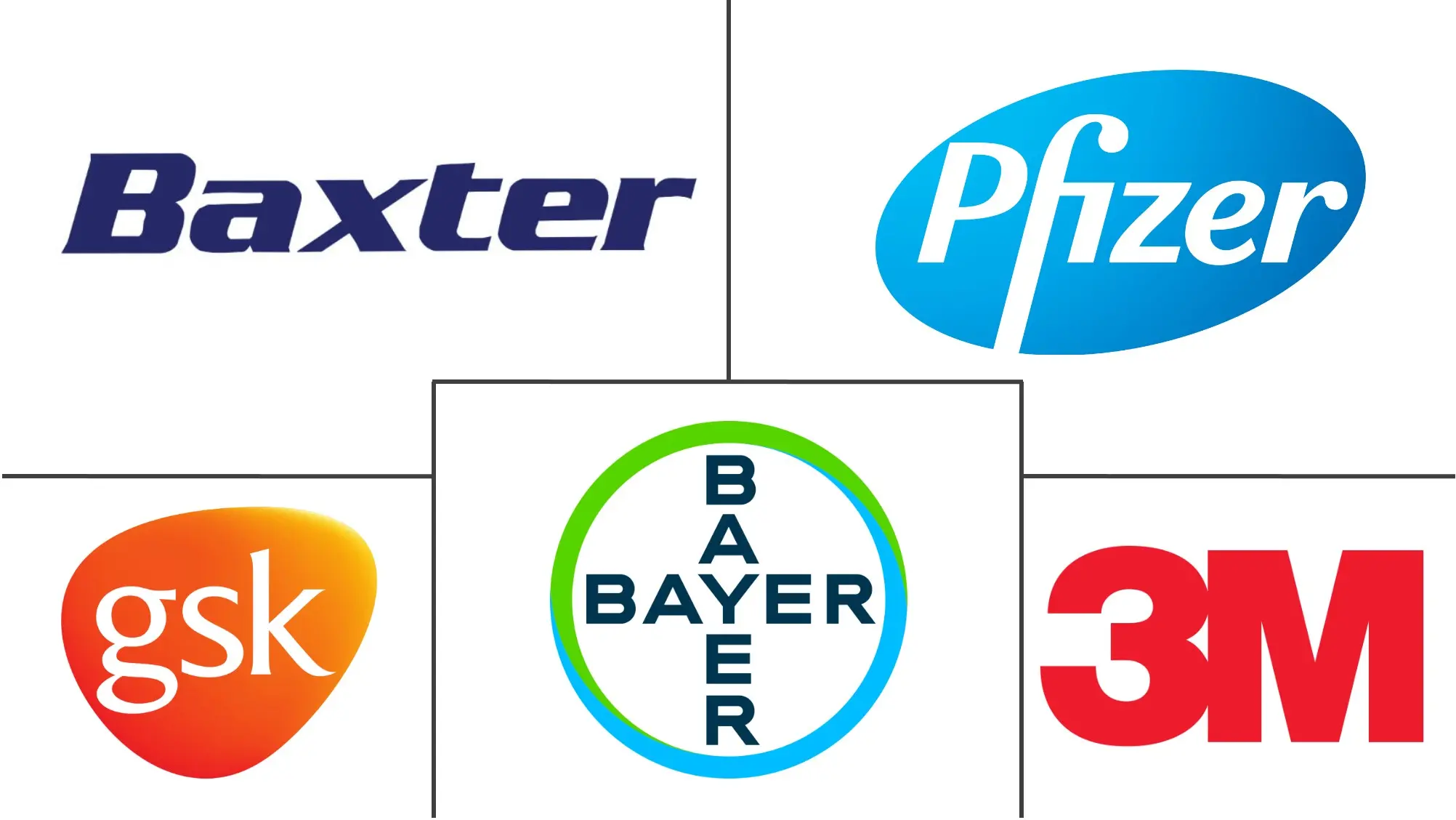Market Size of South Korea Drug Delivery Devices Industry

| Study Period | 2019 - 2029 |
| Base Year For Estimation | 2023 |
| Forecast Data Period | 2024 - 2029 |
| Historical Data Period | 2019 - 2022 |
| CAGR | 7.80 % |
Major Players
*Disclaimer: Major Players sorted in no particular order |
South Korea Drug Delivery Devices Market Analysis
The South Korean market for drug delivery devices is expected to exhibit a CAGR of 7.8% over the forecast period.
- The COVID-19 pandemic led to an increased focus by pharmaceutical companies and governments on providing effective medical therapy to COVID-19 patients, and drug delivery devices are expected to play a crucial role in this regard. Many companies were investing heavily in developing more efficient ways of delivering COVID-19 therapeutics to patients, which had a significant impact on the drug delivery market.
- For instance, in August 2020, Mankind Pharma and Daewoong Pharmaceutical of South Korea collaborated to conduct clinical studies on the anti-parasitic medication niclosamide for Covid-19. Therefore, COVID-19 is expected to have a significant impact on the growth of the drug delivery market over the forecast period. Currently, the use of drug delivery devices for COVID-19 treatment has returned to pre-pandemic levels in South Korea, but the pandemic initially had a significant impact on the market. Nevertheless, the market is expected to experience steady growth over the forecast period.
- Drug delivery devices are specialized tools for delivering drugs or therapeutic agents via a specific route of administration. In South Korea, the demand for these devices has primarily increased due to the rising prevalence of chronic diseases, such as cardiovascular diseases and cancer. For example, according to an article titled "Prediction of Cancer Incidence and Mortality in Korea, 2022," published in PubMed Central, 274,488 new cancer cases are anticipated to occur in Korea in 2022, with thyroid cancer predicted to be the most common type of cancer, followed by lung, colon and rectum, breast, and stomach cancer. Therefore, various types of drug delivery devices play an important role in targeted drug therapy for chronic diseases, thereby boosting the growth of the market.
- Market players are focusing on developing new products and engaging in acquisitions and collaborations, which are expected to fuel market growth during the forecast period. For instance, in November 2021, Innovation Zed, a developer of novel diabetes management technologies, announced the arrival of the InsulCheck DOSE technology (pen Injectable), which is expected to be launched in 2022. However, the increase in the risk of infections and stringent regulatory guidelines for the approval of drug-delivery devices have been limiting the growth of this market.
South Korea Drug Delivery Devices Industry Segmentation
As per the scope of the report, drug delivery devices are specialized tools used for the delivery of a drug or therapeutic agent through a specific route of administration. The devices are used one or more than one times for medical treatments. These devices are also used for safe and effective drug delivery.
The South Korean drug delivery devices market is segmented by mode of administration (injectable, topical, ocular, and others) and end-user (hospitals, ambulatory surgical centers, and other end-users).
The report offers the value (in USD million) for the above segments.
| By Mode of Administration | |
| Injectable | |
| Topical | |
| Ocular | |
| Other Modes of Administration |
| By End-User | |
| Hospitals | |
| Ambulatory Surgical Centers | |
| Other End-Users |
South Korea Drug Delivery Devices Market Size Summary
The South Korean drug delivery devices market is poised for steady growth, driven by the increasing prevalence of chronic diseases such as cardiovascular conditions and cancer. The demand for these specialized tools, which facilitate the administration of drugs through specific routes, has been bolstered by the rising incidence of such diseases. The market's expansion is further supported by the development of innovative products and strategic collaborations among key players. The COVID-19 pandemic initially spurred significant investment in drug delivery technologies, as companies sought efficient methods to administer therapeutics. Although the focus has shifted back to pre-pandemic levels, the impact of these developments continues to influence market dynamics.
The injectable segment, in particular, is expected to experience rapid growth due to the convenience of self-injectors and the expanding biologics market. The increasing burden of chronic diseases, notably diabetes, is a major driver for the use of syringes and self-injectable devices. Additionally, topical drug delivery devices are gaining traction, supported by research highlighting their effectiveness and versatility in managing various conditions. The competitive landscape in South Korea is characterized by the presence of both international and local players, with companies actively pursuing partnerships and product innovations to capture market share. This competitive environment, coupled with a well-structured healthcare system, positions South Korea as a significant market for drug delivery devices.
South Korea Drug Delivery Devices Market Size - Table of Contents
-
1. MARKET DYNAMICS
-
1.1 Market Overview
-
1.2 Market Drivers
-
1.2.1 Increased Prevalence of Chronic Diseases
-
1.2.2 Requirement of Controlled Drug Release
-
-
1.3 Market Restraints
-
1.3.1 Risk of Infection During the Usage and Stringent Regulatory Guidelines
-
-
1.4 Porter's Five Forces Analysis
-
1.4.1 Threat of New Entrants
-
1.4.2 Bargaining Power of Buyers/Consumers
-
1.4.3 Bargaining Power of Suppliers
-
1.4.4 Threat of Substitute Products
-
1.4.5 Intensity of Competitive Rivalry
-
-
-
2. MARKET SEGMENTATION (Market Size By Value - USD million)
-
2.1 By Mode of Administration
-
2.1.1 Injectable
-
2.1.2 Topical
-
2.1.3 Ocular
-
2.1.4 Other Modes of Administration
-
-
2.2 By End-User
-
2.2.1 Hospitals
-
2.2.2 Ambulatory Surgical Centers
-
2.2.3 Other End-Users
-
-
South Korea Drug Delivery Devices Market Size FAQs
What is the current South Korea Drug Delivery Devices Market size?
The South Korea Drug Delivery Devices Market is projected to register a CAGR of 7.80% during the forecast period (2024-2029)
Who are the key players in South Korea Drug Delivery Devices Market?
Bayer, Baxter International, GlaxoSmithKline, 3M Company and Pfizer Inc. are the major companies operating in the South Korea Drug Delivery Devices Market.

